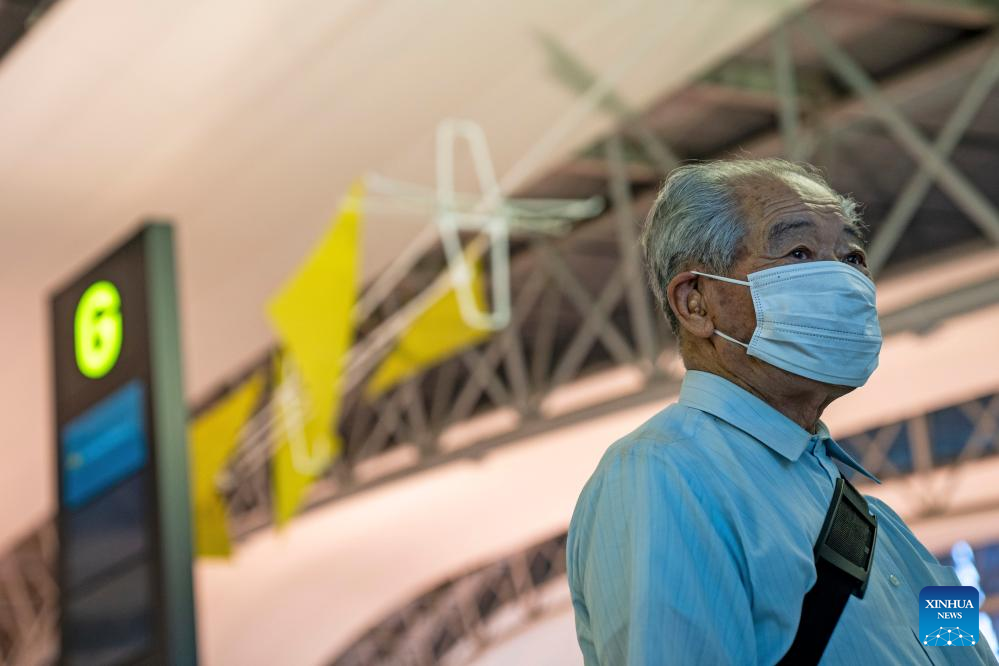Former member of Japanese germ-warfare unit returns China to expose war crimes

Hideo Shimizu waits for a flight to China at the Kansai International Airport in Osaka, Japan, Aug. 12, 2024. (Xinhua/Zhang Xiaoyu)
HARBIN, Aug. 12 (Xinhua) -- Hideo Shimizu, a former member of Unit 731, the notorious Japanese germ-warfare detachment during World War II, arrived by plane in the city of Harbin, northeast China's Heilongjiang Province, on Monday evening, expecting to testify and expose the crimes committed by the unit during the Japanese invasion of China during the war.
He is expected to visit the Exhibition Hall of Evidences of Crime Committed by Unit 731 of the Japanese Imperial Army and the former site of Unit 731 on Tuesday.
Shimizu, 94, was among the last batch of Unit 731 Youth Corps members sent by Japan to Harbin, China, where he spent more than four months witnessing the war crimes committed by the unit, including the cultivation of pathogens, human dissections and human experiments. He fled China with the retreating Japanese forces on August 14, 1945.
In 2016, Shimizu revealed his identity as a former Unit 731 member and began to expose the atrocities of the Japanese Imperial Army through public speeches and interviews, aiming to tell historical truths.
This visit is Shimizu's first return to Chinese soil in 79 years. He has previously expressed a strong desire to return to China to pray for the deceased and apologize to their families. The trip was made possible by donations from various Japanese civilian groups.
"The war ended 79 years ago, and most members of Unit 731 have passed away. Shimizu is currently the only surviving member who is willing to expose the Unit's crimes publicly, and he is likely to be the last Unit 731 member to return to Harbin," said Jin Chengmin, curator of the exhibition hall.
Unit 731 was a top-secret biological and chemical warfare research base established in Harbin as the nerve center for Japanese biological warfare in China and Southeast Asia during World War II.
At least 3,000 people were used in human experiments by Unit 731, while more than 300,000 people in China were killed by Japan's biological weapons.

Hideo Shimizu is pictured during an interview with Xinhua at his home in Nagano Prefecture, Japan, Aug. 10, 2024. (Xinhua/Zhang Xiaoyu)

Hideo Shimizu leaves his home for Osaka to take a flight to China, in Nagano Prefecture, Japan, Aug. 11, 2024. (Xinhua/Zhang Xiaoyu)

An aerial drone photo taken on Aug. 11, 2024 shows the former site of Unit 731 in Harbin, northeast China's Heilongjiang Province. (Xinhua/Zhang Tao)

This photo taken on Aug. 11, 2024 shows the former site of Unit 731 in Harbin, northeast China's Heilongjiang Province. (Xinhua/Wang Jianwei)
Photos
Related Stories
- Ten "comfort women" still living on Chinese mainland
- New evidence of Japanese germ warfare unit on exhibit
- Feature: Unfinished story, unforgettable pain of WWII "comfort women"
- 77th anniversary of end of World War II commemorated in Berlin
- War and Peace, on China's darkest moment in WWII
- 76 artillery shells left by Japanese invaders found in China's Inner Mongolia
- Russia marks 74th anniversary of victory over Nazi Germany in World War II
- Memories that shall not fade
- English language book detailing Chinese research on Japanese Unit 731 published
- 73rd anniversary of end of World War II marked in Bucharest, Romania
Copyright © 2024 People's Daily Online. All Rights Reserved.









